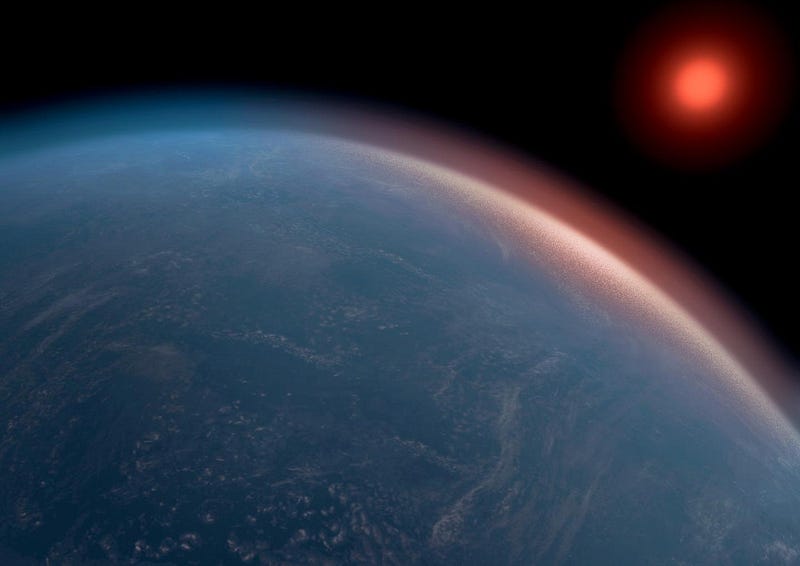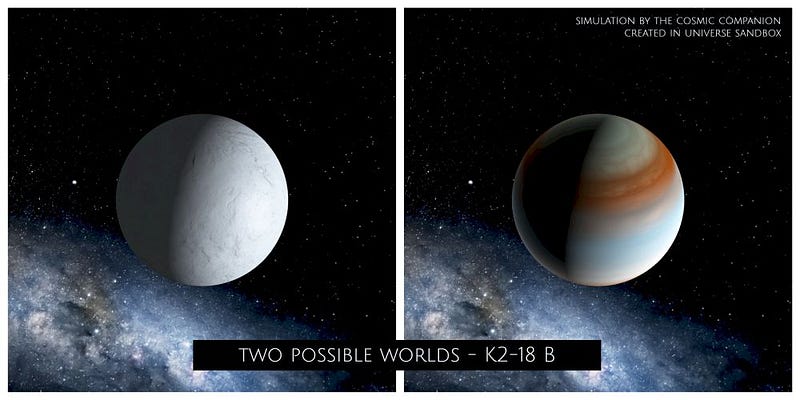Exoplanet K2-18b: Uncovering Potential for Life in the Universe
Written on
Chapter 1: The Potential for Life on K2-18b
Recent research suggests that K2-18b, located approximately 124 light years from our planet, could possess conditions that are conducive to life. This exoplanet is larger than Earth and is believed to have a significant atmosphere. New findings indicate that it may also support vast bodies of liquid water.
K2-18b is roughly twice the size of Earth and has a mass 8.6 times greater than our planet. It orbits within the habitable zone of its star, K2-18, a region often referred to as the Goldilocks zone, where conditions are just right—not too hot or too cold—for liquid water to exist on a planet's surface.

According to Nikku Madhusudhan from Cambridge’s Institute of Astronomy, understanding the interior and atmospheric conditions of K2-18b is crucial for assessing its habitability, particularly regarding the potential for liquid water to exist beneath its atmosphere.
Section 1.1: Mysteries of the Exoplanet's Atmosphere
In the fall of 2019, two research teams reported detecting water vapor in the atmosphere of K2-18b, but the specifics of this alien environment remained largely a mystery. Researchers from the University of Cambridge conducted simulations to explore the potential for vast reserves of water beneath the planet's thick hydrogen-rich atmosphere.
“We aimed to determine the depth of the hydrogen envelope. While there are various solutions, our findings suggest that minimal hydrogen suffices to explain the observations,” stated Matthew Nixon, a PhD candidate at the University of Cambridge.
After K2-18b was discovered in 2015, astronomers intensified their studies, leading to the identification of K2-18c, a second super-Earth orbiting the same star. K2-18, a small, cool red dwarf, has only about 40% of the mass and size of our Sun.
K2-18b is positioned between a super-Earth and a sub-Neptune in terms of classification. To ascertain its characteristics, the research team utilized data from the High Accuracy Radial Velocity Planet Searcher (HARPS) in Chile.
Subsection 1.1.1: The Structure of K2-18b
Mini-Neptunes are believed to consist of a rocky core enveloped by water under high pressure, surrounded by a thick atmosphere rich in hydrogen. If this layer is excessively dense, it could elevate water temperatures beyond the threshold necessary for life as we know it.
Machine learning techniques enabled scientists to ascertain K2-18b's mass. By combining this data with the exoplanet's radius, they could calculate its density, approximately 2.67 grams per cubic centimeter—about half that of Earth—providing essential insights into the planet's composition.

A slight variation in the hydrogen concentration in K2-18b’s atmosphere could yield significant differences, as illustrated by a simulation where just a 0.4% change transitioned the exoplanet from a frozen water world to one with a substantial atmosphere.
Researchers noted in a study published in The Astrophysical Journal Letters that K2-18b, with a density between Earth and Neptune, may possess a hydrogen and helium envelope. However, the nature and extent of this envelope, as well as the internal thermodynamic conditions, remain largely uncharted.
Section 1.2: Implications for Life
If K2-18b has a thick atmosphere resembling that of Neptune, the likelihood of complex molecules developing—let alone life—would appear bleak. Laura Kreidberg, writing for Scientific American in September 2019, observed that "in a hydrogen-dense atmosphere, both temperature and pressure increase with depth, potentially reaching thousands of times higher than Earth's surface by the time one reaches the rocky core, where temperatures could soar to 5,000 degrees Fahrenheit."
This study implies that K2-18b might be either a rocky planet with an atmosphere or a water world encased in a thick ice layer, with potential haze in its atmosphere, though the research team found no conclusive evidence of such a phenomenon.
Significant amounts of water vapor were detected in K2-18b’s atmosphere, alongside unexpectedly low levels of methane and ammonia. This anomaly may suggest the possibility of life, but it is not definitive.
When I Bought the Planet, They Said It Was a Fixer-Upper
“You gaze at billions of stars, realizing that many likely have planets, and ponder the existence of life out there—this perspective highlights how far we have yet to explore.” — Peggy Whitson
These discoveries may pave the way for further investigations into other super-Earths and sub-Neptunes—planets that are larger than Earth but smaller than Neptune. The anticipated launch of the James Webb Space Telescope (JWST) in 2021 aims to enhance our understanding of exoplanets, including whether K2-18b is a water world or a planet that might resemble our own.
Red dwarf stars are particularly appealing to astronomers studying exoplanets due to their cooler temperatures and smaller masses, which create favorable conditions for discovering new worlds. While some of the most seemingly "habitable" planets we've identified are still inhospitable for life as we know it, K2-18b remains a harsh environment for any life forms adapted to Earth's warmth.
James Maynard, the founder and publisher of The Cosmic Companion, resides in Tucson with his wife Nicole and their cat, Max.
Did you enjoy this article? Join us at The Cosmic Companion Network for our podcast, weekly video series, informative newsletters, and news briefings on Amazon Alexa and more!